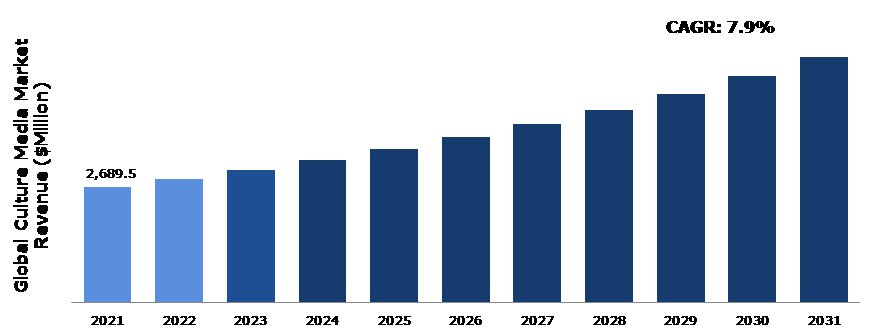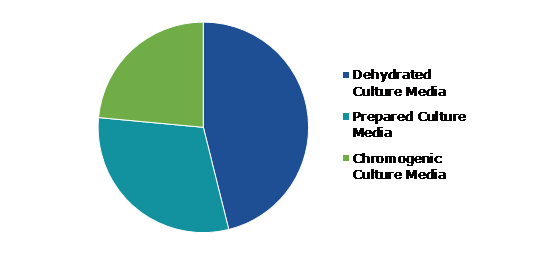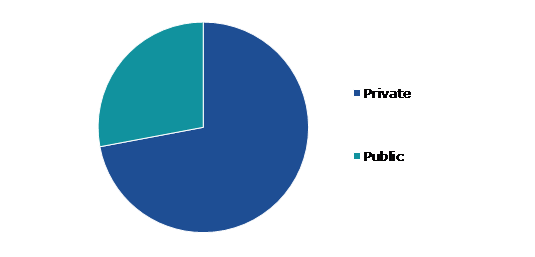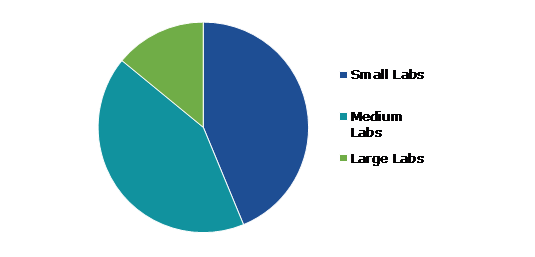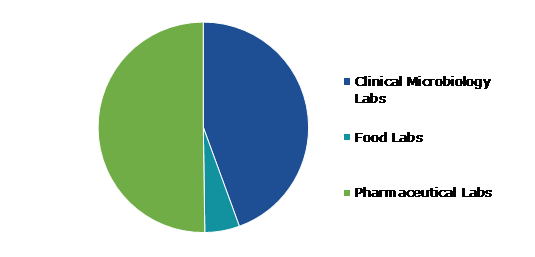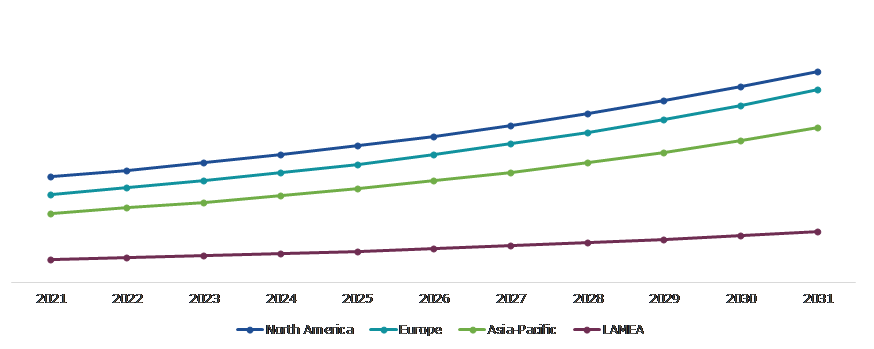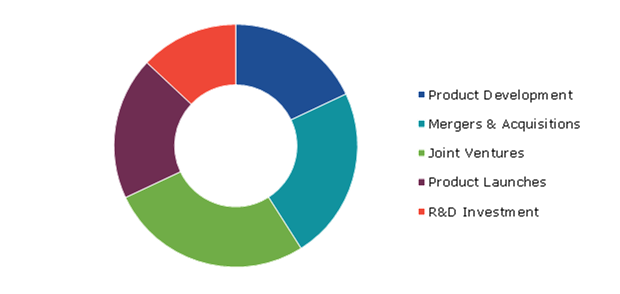Culture Media Market Report
RA00413
Culture Media Market by Media Type (Dehydrated Culture Media, Prepared Culture Media, and Chromogenic Culture Media), Type of Customer (Private and Public), Lab Size (Small Labs, Medium Labs, and Large Labs), End User (Clinical Microbiology Labs, Food Labs, and Pharmaceutical Labs) and Regional Analysis (North America, Europe, Asia-Pacific, and LAMEA): Global Opportunity Analysis and Industry Forecast, 2022–2031
Global Culture Media Market Analysis
The Global Culture Media Market Size was $2,689.5 million in 2021 and is predicted to grow with a CAGR of 7.9%, by generating revenue of $5,736.5 million by 2031.
Global Culture Media Market Synopsis
The surge in demand for cell culture is one of the major factors attributed to the significant growth of the global culture media market. Cell culture is an important reproducible and consistent medium for cellular and molecular biology and aids in the research of cell biochemistry, mutagenesis, normal cell homeostasis, metabolism, and others. It is used as a model system for examining the basic physiology and biochemistry of selected cells. In addition, cell culture helps to understand the effect of drugs on the cells which plays a significant role in clinical trials, the production of vaccines, therapeutic proteins, and drug screening programs. A rise in investment in the development of a novel therapeutic drug for the treatment of cancer is anticipated to further increase the demand for cell culture. All these factors are projected to expand the culture media market growth during the forecast period.
The high cost of cell biology study, lack of skilled professionals along with ethical & scientific concerns regarding cell biology research are likely to impede the culture media market share growth during the forecast period.
An increase in R&D expenditure in the life sciences field, especially in developing economies is anticipated to offer excellent opportunities to culture media market players during the forecast period. Currently, global biopharmaceutical and pharmaceutical R&D spending is highest in countries such as the U.S. and Japan, however, emerging markets including China, India, Russia, South Korea, and Brazil are steadily increasing their prominence in the global market over the past decade.
According to regional analysis, North America accounted for the highest culture media market share in 2021 and is projected to maintain its dominance during the forecast period. The growth of the culture media market in the region is majorly attributed to robust R&D spending, an increase in regulatory approvals for cell culture-based vaccines, and growth in the biotechnology & pharmaceutical industries.
Culture Media Market Overview
Culture media, also known as growth media, is a liquid or gel support medium that contains the necessary nutrients and growth conditions for the growth of microorganisms. Culture media is available in a variety of forms depending on the nutrients they contain and the kinds of microorganisms that they support. For various microbiological experiments, culture media are crucial for obtaining pure cultures, growing and counting microbial cells, and cultivating and choosing microorganisms. Accurate, consistent, and reproducible microbiological test findings are less likely to be obtained without high-quality media.
COVID-19 Impact on Culture Media Market
The COVID-19 outbreak had a moderate impact on the global culture media market. As per the World Health Organization (WHO), the institutions working in the life science R&D field had to work as per the strict government guidelines with proper sanitary measures and social distancing norms. Therefore, several private research laboratories, companies, and academic institutes stopped their research activities due to government norms regarding social distancing and the implementation of strict lockdowns. Research organizations working in R&D and the study of cell lines had to manage their work with the limited culture media resource as they were unable to procure raw materials for culture media research. The downturn in the world economy during the pandemic has declined investments in culture media research and investors delayed their investments. However, vaccine development activities based on cell culture to immunize the global population against the COVID-19 virus offered significant opportunities to some culture media players. An increase in demand for vaccines to eradicate virus transmission has made researchers introduce culture-based vaccines. COVID-19 had a moderate impact on the culture media market due to an increase in demand for vaccinations.
An increase in R&D Investments for Innovation in Life Science is the Major Driving Factor for the Growth of the Global Culture Media Market
Investments in medical technology innovations have enabled significant advancements in patient care. An increase in R&D investments has resulted in a breakthrough in new drug development which is revolutionizing approaches to treat a wide range of chronic and rare diseases. Advanced technologies and innovations including Artificial Intelligence (AI), robotics, Real-World Evidence (RWE), digital health, and telemedicine impact R&D across the whole value chain – from drug discovery to clinical trials and regulatory reporting. Furthermore, the use of genomics is helping medical practitioners to provide customized treatment to the specific requirements of patients while a breakthrough in immunotherapy is helping patients’ immune systems to fight off various conditions, including cancer and rare diseases.
According to the Pharmaceutical Research and Manufacturers of America, various biopharmaceutical firms invested around half a trillion dollars in R&D for complicated and rare diseases in the last decade alone. Fujifilm corporation has announced an investment of $188 million to establish culture media manufacturing facility in 2022. For more than 30 years, the U.S. biopharmaceutical has been an industry leader in new drug development. The member of Pharmaceutical Research and Manufacturers of America invested $83 billion in R&D activities in 2019, making the biopharmaceutical sector the most R&D-intensive industry in the U.S.
The Lack of Skilled Professionals and Ethical & Scientific Concerns Associated with Culture Media to Impede the Market Growth
The global biopharmaceutical industry is constantly evolving and is embracing innovative technologies such as artificial intelligence, robotics, real-world evidence, and process analytical technology in drug manufacturing. The evolution of the biopharmaceutical industry is majorly attributed to the changes brought to the conventional manufacturing process with a shift from conventional chemical synthesis to the genetic manipulation of living organisms. To manufacture complex biological and gene therapeutics safely and efficiently and to meet volume requirements, biopharmaceutical companies need a significant transformation in the coming years. As the biopharmaceutical sector embraces advanced and novel technologies, there is an increase in talent as the skills of the pharmaceutical labor force have not yet aligned with this new age of biopharmaceutical manufacturing. Biopharmaceutical companies are struggling to find the talent they need in advanced areas such as automation, computer science, and process modeling, not historically core skills in conventional pharmaceutical manufacturing, but now essential to modern biopharmaceutical manufacturing. If left unchecked and untreated, these skill gaps could impede innovation regarding the use of culture media in complex biological, pharmaceuticals, and others.
Increase in R&D Spending in Emerging Markets to Provide Significant Growth Opportunities in the Market in the Coming Years
While global biopharmaceutical and pharmaceutical R&D spending has been dominated by countries such as the U.S. and Japan, however, emerging market including China, India, Russia, South Korea, and Brazil are steadily increasing their prominence in the global market over the past decade. China has witnessed around 27% growth in R&D expenditure over the decade. The country has around 620 products in the pipeline of which small molecules and monoclonal antibodies account for more than 50% share. Followed by China, South Korea has witnessed 14% growth in R&D activities, about 610 products in the pipeline of which small molecules account for a major market share. Among the emerging economies, India is the only country to witness positive growth in R&D activities. The country has more than 400 products in the pipeline while the major focus is on biosimilar, small molecules, and recombinant proteins. With an increase in R&D spending, emerging markets are the blooming hotspot for clinical trials. The yearly growth rate for clinical trials worldwide is around 10% to 12%. The increase in clinical trials in emerging markets is owing to an increase in access to technologies and improvement in healthcare infrastructure.
Global Culture Media Market, by Media Type
Based on media type, the market is further divided into dehydrated culture media, prepared culture media, and chromogenic culture media. Among these, the dehydrated culture media sub-segment held the largest share of the global culture media market in 2021.
Global Culture Media Market Size, by Media Type, 2021
Source: Research Dive Analysis
The dehydrated culture media sub-segment held the largest market share in 2021. A dehydrated culture media is designed for the growth of microorganisms. For microorganisms to survive and reproduce, the components of a dehydrated culture medium must meet their nutritional needs for nutrients such as nitrogen, carbon, and trace elements. Dehydrated culture media are widely used in the day-to-day operation by most microbiology laboratories, as it provides various benefits such as long shelf life, convenience, waste-free, and cost-effectiveness. Furthermore, this media has a wide range of applications in industrial microbiology (pharmaceutical, cosmetics, vaccine production, food industry, animal health, analysis laboratories, and others), or clinical microbiology (human and veterinary). The dehydrated culture media gives culture medium a longer shelf life of up to five years, allowing microorganisms to grow comfortably and easily. The rise in demand for novel vaccines, antibiotics, and oral insulin is the major factor driving demand for dehydrated culture media in the global market. Furthermore, an increase in investment in R&D activities for the development of next-generation biologics is expected to augment the demand for dehydrated culture media in the future. Several pharmaceutical companies around the world are competing to develop novel coronavirus vaccines. Moreover, patents for most biologics will expire in the coming years which will lead to an increase in the production of generic molecules. Such factors are expected to boost demand for dehydrated culture media during the forecast period.
Global Culture Media Market, by Type of Customer
Based on type of customer, the global culture media market has been divided into private and public. Among these, the private sub-segment is anticipated to witness the fastest CAGR during the forecast period.
Global Culture Media Market Share, by Type of Customer, 2021
Source: Research Dive Analysis
The private sub-segment is expected to have the fastest growth during the forecast period. Private customers majorly include private research laboratories, academic institutions, microbial research centers, and private companies that are active in this market. These private organizations actively participate in research-oriented projects like studying cell morphology and stem cell proliferation. These studies involve culturing a variety of cells in controlled lab environments and require a continuous supply of nutritious cell culture media. For instance, HiMedia Laboratories, is one of the top three microbiological brands in the world, with its presence in more than 140 nations. The company globally manufactures and distributes a different variety of culture media. Furthermore, BIOMARK Laboratories is another leading private laboratory that started utilizing the expertise of a multidisciplinary team to provide a wide range of culture medium products for microbiological testing. This lab offers dehydrated culture media, along with ready-prepared culture media, tissue culture media, culture media bases, antimicrobial sensitivity and bacteriological differentiation discs, stains, and staining reagents, which are among the cutting-edge technology products produced and exported by BIOMARK Laboratories. Thus, the high penetration of such private companies supports the demand and supply of culture media which is boosting the culture media market growth considerably.
Global Culture Media Market, by Lab Size
Based on lab size, the global culture media market has been divided into small labs, medium labs, and large labs. Among these, the medium labs sub-segment is anticipated to show the fastest CAGR during the forecast period.
Global Culture Media Market Growth, by Lab Size, 2021
Source: Research Dive Analysis
The medium labs sub-segment is expected to have the fastest growth during the forecast period. The medium lab is also known as pharmaceutical manufacturing unit labs which are the biopharmaceutical company manufacturing unit labs, and food processing manufacturing unit labs. Pharmaceutical manufacturing labs are positioned to create novel products with growth potential from a foundation of basic research. The number of R&D centers and research labs is increasing across the world. The increase in R&D activities, investment, and innovations in the life sciences are anticipated to boost the culture media market expansion. For instance, the Pharmaceutical Research and Manufacturers of America estimates that biopharmaceutical companies have spent nearly $500 billion on R&D for treating complicated and challenging diseases in the last decade. This factor is anticipated to accelerate the expansion of medium labs during the forecast period. Furthermore, the increase in demand for novel vaccines and drugs in labs has fueled the number of biotechnology companies across the world. The increase in the use of single-use technologies, the increase in the number of regulatory approvals for culture-based vaccines, and the presence of a large number of pharmaceutical players in this market are driving the culture media market expansion.
The small labs sub-segment held the largest market share in 2021. The small lab is considered an independent diagnostic lab, clinic lab, hospital lab, school and college lab, and academic institute lab. In small labs, the culture media are mediums that provide essential nutrients and minerals to support the growth of microorganisms in the laboratory. Microorganisms cannot be cultured with just one kind of culture medium because of their diverse nature, traits, habitats, and even dietary needs. In the culture media market, a small lab means an academic lab or a diagnostic lab. Performing any diagnostic or other screening procedures on any biological agent or material takes place in a diagnostic laboratory. Diagnostic labs typically perform tests on clinical materials such as blood, urine, triglycerides, or cholesterol levels. Medical experts perform such tests to gather patient health data for disease prevention, diagnosis, and treatment.
Global Culture Media Market, by End User
Based on end user, the global culture media market has been classified into clinical microbiology labs, food labs, and pharmaceutical labs. Among these, the clinical microbiology labs sub-segment is anticipated to show the fastest CAGR during the forecast period.
Global Culture Media Market Analysis, by End User, 2021
Source: Research Dive Analysis
The clinical microbiology labs sub-segment is expected to have the fastest growth during the forecast period. Clinical microbiology is defined as a field of research that examines how macro- and microorganisms interact under normal and pathological conditions and in the dynamics of a pathological process, with a description of the treatment up until the clinical and/or full recovery. For instance, the M.F. Vladimirski Moscow Region Research Clinical Institute's clinical microbiologists have made significant contributions to basic research on the pathogenesis and mechanisms of action of antibiotics, immunological preparations, and physiotherapies, such as UV and laser application, with regard to patients and opportunistic bacteria.
Global Culture Media Market, Regional Insights
The culture media market was investigated across North America, Europe, Asia-Pacific, and LAMEA.
Global Culture Media Market Size & Forecast, by Region, 2021-2031 ($Million)
Source: Research Dive Analysis
North America Dominated the Culture Media Market in 2021
North America dominated the global culture media market in 2021. Higher investments in cell-based research and the rise in the incidence of diseases such as cancer are expected to drive the growth of the culture media market in North America. Cancer is the second-leading cause, after heart disease, in the U.S. and the leading cause of death in Canada. As per the estimates by the American Cancer Society, a voluntary health organization, in 2021, approximately 1.9 million new cancer cases and 693,000 cancer deaths were estimated to have occurred in the U.S. The increase in the number of culture media market players and suppliers across the region is expected to drive market growth further. For instance, some of the prominent raw material manufacturers for cell culture media in the U.S. are Rocky Mountain Biologicals, Inc., ALine, Inc., Impact Diagnostic International, and others. Moreover, an increase in investments by prominent players in product capabilities and business expansion is expected to drive the market during the forecast period.
Global Culture Media Market Competitive Scenario
Joint ventures, investment, merger & acquisition, product development, and technological development are the common strategies followed by major culture media market players. For instance, in 2021, BD (Becton, Dickinson, and Company) announced the availability in the U.S. of a Urine Culture Application for use with the BD KiestraTM lab automation incubation and imaging system, which has the potential to alter the way microbiology labs manage urine culture analysis.
Source: Research Dive Analysis
Some of the leading players in the culture media market are BD, BioMérieux SA, Thermo Fisher Scientific Inc., HImedia Laboratories Private Limited, Fujifilm Holdings Corporation, Merck & Co., Inc., Corning Incorporated, Lonza, CellGenix GmbH, and Sartorius AG.
| Aspect | Particulars |
| Historical Market Estimations | 2020 |
| Base Year for Market Estimation | 2021 |
| Forecast timeline for Market Projection | 2022-2031 |
| Geographical Scope | North America, Europe, Asia-Pacific, and LAMEA |
| Segmentation by Media Type
|
|
| Segmentation by Type of Customer |
|
| Segmentation by Lab Size |
|
| Segmentation by End User |
|
| Key Companies Profiled |
|
Q1. What is the size of the culture media market?
A. The global culture media market size was over $2,689.5 million in 2021 ¬¬and is anticipated to reach $5,736.5 million by 2031.
Q2. Which are the leading companies in the culture media market?
A. BD, Thermo Fisher Scientific Inc., and Corning Incorporated are some of the key players in the global culture media market.
Q3. Which region possesses greater investment opportunities in the coming future?
A. Asia-Pacific possesses great investment opportunities for investors in the coming years.
Q4. What is the growth rate of the Asia-Pacific market?
A. The Asia-Pacific culture media market is anticipated to grow at 8.4% CAGR during the forecast period.
Q5. What are the strategies opted by the leading players in this market?
A. Product innovations, business expansions, and technological advancements are the key strategies opted by the operating companies in this market.
Q6. Which companies are investing more in R&D practices?
A. Sartorius AG, BioMérieux SA, and Lonza are investing more on R&D activities for developing new products and technologies.
1.Research Methodology
1.1.Desk Research
1.2.Real-time insights and validation
1.3.Forecast model
1.4.Assumptions and forecast parameters
1.5.Market size estimation
1.5.1.Top-down approach
1.5.2.Bottom-up approach
2.Report Scope
2.1.Market Definition
2.2.Key objectives of the study
2.3.Report Overview
2.4.Market segmentation
2.5.Overview of the impact of COVID-19 on Global Culture Media market
3.Executive Summary
4.Market Overview
4.1.Introduction
4.2.Growth impact forces
4.2.1.Drivers
4.2.2.Restraints
4.2.3.Opportunities
4.3.Market value chain analysis
4.3.1.List of raw material suppliers
4.3.2.List of manufacturers
4.3.3.List of distributors
4.4.Innovation & sustainability matrices
4.4.1.Technology matrix
4.4.2.Regulatory matrix
4.5.Porter’s five forces analysis
4.5.1.Bargaining power of suppliers
4.5.2.Bargaining power of consumers
4.5.3.Threat of substitutes
4.5.4.Threat of new entrants
4.5.5.Competitive rivalry intensity
4.6.PESTLE analysis
4.6.1.Political
4.6.2.Economical
4.6.3.Social
4.6.4.Technological
4.6.5.Environmental
4.7.Impact of COVID-19 on Culture Media market
4.7.1.Pre-covid market scenario
4.7.2.Post-covid market scenario
5.Culture Media Market Analysis, by Media Type
5.1.Overview
5.2.Dehydrated Culture Media
5.2.1.Definition, key trends, growth factors, and opportunities
5.2.2.Market size analysis, by region, 2021-2031
5.2.3.Market share analysis, by country, 2021-2031
5.3.Prepared Culture Media
5.3.1.Definition, key trends, growth factors, and opportunities
5.3.2.Market size analysis, by region, 2021-2031
5.3.3.Market share analysis, by country, 2021-2031
5.4.Chromogenic Culture Media
5.4.1.Definition, key trends, growth factors, and opportunities
5.4.2.Market size analysis, by region, 2021-2031
5.4.3.Market share analysis, by country, 2021-2031
5.5.Research Dive Exclusive Insights
5.5.1.Market attractiveness
5.5.2.Competition heatmap
6.Culture Media Market Analysis, by Type of Customer
6.1.Private
6.1.1.Definition, key trends, growth factors, and opportunities
6.1.2.Market size analysis, by region, 2021-2031
6.1.3.Market share analysis, by country, 2021-2031
6.2.Public
6.2.1.Definition, key trends, growth factors, and opportunities
6.2.2.Market size analysis, by region, 2021-2031
6.2.3.Market share analysis, by country, 2021-2031
6.3.Research Dive Exclusive Insights
6.3.1.Market attractiveness
6.3.2.Competition heatmap
7.Culture Media Market Analysis, by Lab Size
7.1.Small Labs
7.1.1.Definition, key trends, growth factors, and opportunities
7.1.2.Market size analysis, by region, 2021-2031
7.1.3.Market share analysis, by country, 2021-2031
7.2.Medium Labs
7.2.1.Definition, key trends, growth factors, and opportunities
7.2.2.Market size analysis, by region, 2021-2031
7.2.3.Market share analysis, by country, 2021-2031
7.3.Large Labs
7.3.1.Definition, key trends, growth factors, and opportunities
7.3.2.Market size analysis, by region, 2021-2031
7.3.3.Market share analysis, by country, 2021-2031
7.4.Research Dive Exclusive Insights
7.4.1.Market attractiveness
7.4.2.Competition heatmap
8.Culture Media Market Analysis, by End User
8.1.Clinical Microbiology Labs
8.1.1.Definition, key trends, growth factors, and opportunities
8.1.2.Market size analysis, by region, 2021-2031
8.1.3.Market share analysis, by country, 2021-2031
8.2.Food Labs
8.2.1.Definition, key trends, growth factors, and opportunities
8.2.2.Market size analysis, by region, 2021-2031
8.2.3.Market share analysis, by country, 2021-2031
8.3.Pharmaceutical Labs
8.3.1.Definition, key trends, growth factors, and opportunities
8.3.2.Market size analysis, by region, 2021-2031
8.3.3.Market share analysis, by country, 2021-2031
8.4.Research Dive Exclusive Insights
8.4.1.Market attractiveness
8.4.2.Competition heatmap
9.Culture Media Market, by Region
9.1.North America
9.1.1.U.S.
9.1.1.1.Market size analysis, by Media Type, 2021-2031
9.1.1.2.Market size analysis, by Type of Customer, 2021-2031
9.1.1.3.Market size analysis, by Lab Size, 2021-2031
9.1.1.4.Market size analysis, by End User, 2021-2031
9.1.2.Canada
9.1.2.1.Market size analysis, by Media Type, 2021-2031
9.1.2.2.Market size analysis, by Type of Customer, 2021-2031
9.1.2.3.Market size analysis, by Lab Size, 2021-2031
9.1.2.4.Market size analysis, by End User, 2021-2031
9.1.3.Mexico
9.1.3.1.Market size analysis, by Media Type, 2021-2031
9.1.3.2.Market size analysis, by Type of Customer, 2021-2031
9.1.3.3.Market size analysis, by Lab Size, 2021-2031
9.1.3.4.Market size analysis, by End User, 2021-2031
9.1.4.Research Dive Exclusive Insights
9.1.4.1.Market attractiveness
9.1.4.2.Competition heatmap
9.2.Europe
9.2.1.Germany
9.2.1.1.Market size analysis, by Media Type, 2021-2031
9.2.1.2.Market size analysis, by Type of Customer, 2021-2031
9.2.1.3.Market size analysis, by Lab Size, 2021-2031
9.2.1.4.Market size analysis, by End User, 2021-2031
9.2.2.UK
9.2.2.1.Market size analysis, by Media Type, 2021-2031
9.2.2.2.Market size analysis, by Type of Customer, 2021-2031
9.2.2.3.Market size analysis, by Lab Size, 2021-2031
9.2.2.4.Market size analysis, by End User, 2021-2031
9.2.3.Spain
9.2.3.1.Market size analysis, by Media Type, 2021-2031
9.2.3.2.Market size analysis, by Type of Customer, 2021-2031
9.2.3.3.Market size analysis, by Lab Size, 2021-2031
9.2.3.4.Market size analysis, by End User, 2021-2031
9.2.4.Italy
9.2.4.1.Market size analysis, by Media Type, 2021-2031
9.2.4.2.Market size analysis, by Type of Customer, 2021-2031
9.2.4.3.Market size analysis, by Lab Size, 2021-2031
9.2.4.4.Market size analysis, by End User, 2021-2031
9.2.5.Rest of Europe
9.2.5.1.Market size analysis, by Media Type, 2021-2031
9.2.5.2.Market size analysis, by Type of Customer, 2021-2031
9.2.5.3.Market size analysis, by Lab Size, 2021-2031
9.2.5.4.Market size analysis, by End User, 2021-2031
9.2.6.Research Dive Exclusive Insights
9.2.6.1.Market attractiveness
9.2.6.2.Competition heatmap
9.3.Asia-Pacific
9.3.1.China
9.3.1.1.Market size analysis, by Media Type, 2021-2031
9.3.1.2.Market size analysis, by Type of Customer, 2021-2031
9.3.1.3.Market size analysis, by Lab Size, 2021-2031
9.3.1.4.Market size analysis, by End User, 2021-2031
9.3.2.Japan
9.3.2.1.Market size analysis, by Media Type, 2021-2031
9.3.2.2.Market size analysis, by Type of Customer, 2021-2031
9.3.2.3.Market size analysis, by Lab Size, 2021-2031
9.3.2.4.Market size analysis, by End User, 2021-2031
9.3.3.India
9.3.3.1.Market size analysis, by Media Type, 2021-2031
9.3.3.2.Market size analysis, by Type of Customer, 2021-2031
9.3.3.3.Market size analysis, by Lab Size, 2021-2031
9.3.3.4.Market size analysis, by End User, 2021-2031
9.3.4.Australia
9.3.4.1.Market size analysis, by Media Type, 2021-2031
9.3.4.2.Market size analysis, by Type of Customer, 2021-2031
9.3.4.3.Market size analysis, by Lab Size, 2021-2031
9.3.4.4.Market size analysis, by End User, 2021-2031
9.3.5.South Korea
9.3.5.1.Market size analysis, by Media Type, 2021-2031
9.3.5.2.Market size analysis, by Type of Customer, 2021-2031
9.3.5.3.Market size analysis, by Lab Size, 2021-2031
9.3.5.4.Market size analysis, by End User, 2021-2031
9.3.6.Rest of Asia-Pacific
9.3.6.1.Market size analysis, by Media Type, 2021-2031
9.3.6.2.Market size analysis, by Type of Customer, 2021-2031
9.3.6.3.Market size analysis, by Lab Size, 2021-2031
9.3.6.4.Market size analysis, by End User, 2021-2031
9.3.7.Research Dive Exclusive Insights
9.3.7.1.Market attractiveness
9.3.7.2.Competition heatmap
9.4.LAMEA
9.4.1.Brazil
9.4.1.1.Market size analysis, by Media Type, 2021-2031
9.4.1.2.Market size analysis, by Type of Customer, 2021-2031
9.4.1.3.Market size analysis, by Lab Size, 2021-2031
9.4.1.4.Market size analysis, by End User, 2021-2031
9.4.2.Saudi Arabia
9.4.2.1.Market size analysis, by Media Type, 2021-2031
9.4.2.2.Market size analysis, by Type of Customer, 2021-2031
9.4.2.3.Market size analysis, by Lab Size, 2021-2031
9.4.2.4.Market size analysis, by End User, 2021-2031
9.4.3.UAE
9.4.3.1.Market size analysis, by Media Type, 2021-2031
9.4.3.2.Market size analysis, by Type of Customer, 2021-2031
9.4.3.3.Market size analysis, by Lab Size, 2021-2031
9.4.3.4.Market size analysis, by End User, 2021-2031
9.4.4.South Africa
9.4.4.1.Market size analysis, by Media Type, 2021-2031
9.4.4.2.Market size analysis, by Type of Customer, 2021-2031
9.4.4.3.Market size analysis, by Lab Size, 2021-2031
9.4.4.4.Market size analysis, by End User, 2021-2031
9.4.5.Rest of LAMEA
9.4.5.1.Market size analysis, by Media Type, 2021-2031
9.4.5.2.Market size analysis, by Type of Customer, 2021-2031
9.4.5.3.Market size analysis, by Lab Size, 2021-2031
9.4.5.4.Market size analysis, by End User, 2021-2031
9.4.6.Research Dive Exclusive Insights
9.4.6.1.Market attractiveness
9.4.6.2.Competition heatmap
10.Competitive Landscape
10.1.Top winning strategies, 2021
10.1.1.By strategy
10.1.2.By year
10.2.Strategic overview
10.3.Market share analysis, 2021
11.Company Profiles
11.1.BD
11.1.1.Overview
11.1.2.Business segments
11.1.3.Product portfolio
11.1.4.Financial performance
11.1.5.Recent developments
11.1.6.SWOT analysis
11.2.BioMérieux SA
11.2.1.Overview
11.2.2.Business segments
11.2.3.Product portfolio
11.2.4.Financial performance
11.2.5.Recent developments
11.2.6.SWOT analysis
11.3.Thermo Fisher Scientific Inc.
11.3.1.Overview
11.3.2.Business segments
11.3.3.Product portfolio
11.3.4.Financial performance
11.3.5.Recent developments
11.3.6.SWOT analysis
11.4.HiMedia Laboratories Private Limited
11.4.1.Overview
11.4.2.Business segments
11.4.3.Product portfolio
11.4.4.Financial performance
11.4.5.Recent developments
11.4.6.SWOT analysis
11.5.Fujifilm Holdings Corporation
11.5.1.Overview
11.5.2.Business segments
11.5.3.Product portfolio
11.5.4.Financial performance
11.5.5.Recent developments
11.5.6.SWOT analysis
11.6.Merck & Co.
11.6.1.Overview
11.6.2.Business segments
11.6.3.Product portfolio
11.6.4.Financial performance
11.6.5.Recent developments
11.6.6.SWOT analysis
11.7.Corning Incorporated
11.7.1.Overview
11.7.2.Business segments
11.7.3.Product portfolio
11.7.4.Financial performance
11.7.5.Recent developments
11.7.6.SWOT analysis
11.8.Lonza
11.8.1.Overview
11.8.2.Business segments
11.8.3.Product portfolio
11.8.4.Financial performance
11.8.5.Recent developments
11.8.6.SWOT analysis
11.9.CellGenix GmbH
11.9.1.Overview
11.9.2.Business segments
11.9.3.Product portfolio
11.9.4.Financial performance
11.9.5.Recent developments
11.9.6.SWOT analysis
11.10.Sartorius AG
11.10.1.Overview
11.10.2.Business segments
11.10.3.Product portfolio
11.10.4.Financial performance
11.10.5.Recent developments
11.10.6.SWOT analysis
Culture media also known as growth media is a substance or special medium that encourages the growth of the population of cells or microorganisms via the process of cell proliferation. It contains nutrients, buffer salts, energy sources, minerals, gelling agents, and metals which are necessary for microbial growth.
Culture media is used in research centers and microbiological laboratories to grow & control cells. The cell culture media is composed of an array of amino acids, vitamins, glucose as an energy source, inorganic salts, and serum as a source of attachment & growth factors and hormones. Currently, the increased usage of techniques that are found in the pharmaceutical industry quality control laboratories require the growth of media.
COVID-19 Impact and Forecast Analysis of Culture Media Market
The global culture media market is anticipated to witness a decline in the growth rate during the COVID-19 pandemic. The biopharmaceutical processing industries across the globe are facing operational problems owing to a vital spur in the demand for vaccines and biologics to treat the novel coronavirus.
The culture media market is anticipated to observe a strong growth over the forecast period due to the existence of skilled workforce, easy availability of raw materials, and favorable government policies all around the world. The continuous technological advancements in culture media is predicted to play a vital role in creating enormous growth opportunities in the global market. However, the scientific & ethical concerns associated with culture media and the lack of skilled professionals are expected to hinder the market growth in the near future.
The growing prevalence of chronic and incurable diseases across the globe and the rising investments in R&D for innovation in life sciences are the major factors estimated to foster the growth of the global market by 2031. Research Dive in its latest published report projects that the culture media market will grow at a CAGR of 7.9% during the forecast period.
Culture Media Market Trends and Developments
The key players functioning in the global industry include BD, Thermo Fisher Scientific Inc., BioMérieux SA, HImedia Laboratories Private Limited, Merck & Co., Inc., Fujifilm Holdings Corporation, Corning Incorporated, CellGenix GmbH, Lonza, and Sartorius AG. These industry players are adopting various growth strategies & business tactics such as technological advancements, geographical expansion, and novel product launches to maintain a robust position in the overall market, which is subsequently helping the culture media market to grow at a robust pace. For instance:
- In October 2019, Thermo Fisher Scientific introduced ‘Gibco BenchStable Media,’ which is a cell culture media that is when stored at room temperature remains stable. Gibco BenchStable Media is packed in fully recyclable boxes and it’s packaging virtually eliminates light exposure.
- In July 2021, Sartorius AG, the life science company through its subgroup Sartorius Stedim Biotech, completed the acquisition of cell culture specialist Xell AG, which is headquartered in Bielefeld, Germany. Xell AG is an innovative partner for the biotech & pharmaceutical industry that develops, produces, and also markets media & feed supplements for cell cultures, mostly for manufacturing viral vectors used in gene therapeutics and vaccines.
- In December 2021, FUJIFILM Irvine Scientific, Inc., a global leader in the manufacture and development of serum-free & chemically defined cell culture media for bioproduction and cell therapy manufacturing, established an Innovation & Collaboration Center in Suzhou New District, China. With this center, experts will collaborate with customers to design upstream cell culture processes that meet their biomanufacturing needs.
Most Profitable Region
The North America region is anticipated to dominate in the global culture media market throughout the forecast period owing to the increasing focus of companies in the region towards innovation & development of biologics. Besides, higher investments in cell-based research and the growing prevalence of such as cancer in the region are the factors expected to drive the growth of the North America culture media market.
Personalize this research
- Triangulate with your own data
- Request your format and definition
- Get a deeper dive on a specific application, geography, customer or competitor
- + 1-888-961-4454 Toll - Free
- support@researchdive.com

